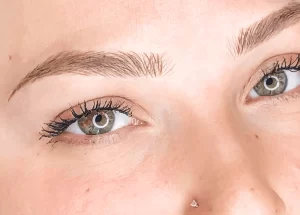Welcome to our article on the Microblading Course Curriculum. In this guide, we will explore how this curriculum can empower your business vision and help you launch your ideal microblading course. As professionals in the beauty industry, it’s crucial to stay ahead and offer high-quality training programs to meet the growing demand for microblading services.
Throughout this article, we will delve into the key components of a comprehensive microblading training curriculum. From mastering fundamental techniques to acquiring advanced skills, we will provide valuable insights to enhance your training program.
Additionally, we will discuss the significance of aligning your curriculum with your unique brand and goals. This alignment will not only attract the right students but also help you build a strong reputation in the industry.
Join us as we explore the world of microblading training curriculums and discover how you can empower your business vision through a well-designed and strategic training program.
Key Takeaways
- A well-structured microblading course curriculum provides comprehensive training and acts as a roadmap for learning microblading techniques.
- Key elements in a microblading training curriculum include theory and anatomy, hands-on practice, client consultation and communication, and business and marketing strategies.
- Practical hands-on experience in a microblading training curriculum is important for building muscle memory, improving technique, boosting confidence, and enhancing problem-solving skills.
- Adapting the microblading training curriculum to industry trends and regulations ensures relevance, incorporates updates on techniques and safety protocols, and prepares students to meet the needs of clients and navigate the industry with confidence.
Understanding the Importance of a Well-Structured Microblading Course Curriculum
A well-structured microblading course curriculum is essential for providing comprehensive training and empowering aspiring microblading professionals with the necessary skills and knowledge. It acts as a roadmap, guiding students through the various aspects of microblading, from the basics to the advanced techniques.
The curriculum should cover topics such as the history and theory of microblading, understanding different skin types and face shapes, color theory, hygiene and safety protocols, client consultation, and aftercare. It should also include practical hands-on training, where students can practice their skills on models under the guidance of experienced instructors.
By following a well-structured curriculum, students can develop a strong foundation in microblading and gain the confidence to start their own successful businesses. They will be equipped with the knowledge and skills to create beautiful, natural-looking eyebrow enhancements that meet the expectations of their clients.
Ultimately, a comprehensive curriculum sets the stage for success in the world of microblading.
Key Elements to Include in Your Microblading Course Curriculum
Including essential elements in your microblading course curriculum is crucial for providing comprehensive training and ensuring the success of aspiring microblading professionals.
To create a curriculum that resonates with your audience and fosters a sense of belonging, consider including the following key elements:
- Theory and Anatomy: Cover the fundamentals of microblading, including skin anatomy, color theory, and safety protocols.
- Hands-on Practice: Provide ample opportunities for students to practice their microblading skills on artificial skin and live models under the guidance of experienced instructors.
- Client Consultation and Communication: Teach students how to effectively communicate with clients, understand their needs, and manage their expectations.
- Business and Marketing Strategies: Equip students with the knowledge and skills to start and grow their microblading businesses, including branding, pricing, and marketing.
Designing a Comprehensive Training Program for Microblading
To create a comprehensive training program for microblading, it is essential to carefully design the curriculum with a focus on providing students with the necessary skills and knowledge.
The training program should cover a wide range of topics, including the fundamentals of microblading, such as brow shaping and mapping, color theory, and sanitation practices.

It should also include hands-on practice sessions where students can apply their knowledge and develop their technique under the guidance of experienced instructors.
Additionally, the program should incorporate business and marketing strategies to help students establish and grow their microblading businesses.
A comprehensive training program should not only equip students with the technical skills needed to perform microblading procedures, but also provide them with the tools and resources to succeed in the industry.
Incorporating Practical Hands-On Experience in Your Microblading Course Curriculum
To enhance the learning experience, it is imperative to include practical hands-on training in your microblading training curriculum. By incorporating practical hands-on experience, students are able to develop their skills and gain confidence in their abilities. This type of training allows them to apply the theoretical knowledge they have learned in a real-world setting, giving them a deeper understanding of the techniques and processes involved in microblading.
Here are four reasons why practical hands-on experience is essential in a microblading course curriculum:
- Builds muscle memory: Hands-on practice helps students develop muscle memory, allowing them to perform microblading techniques with precision and accuracy.
- Improves technique: Practical training allows students to refine their techniques under the guidance of experienced instructors, helping them master the art of microblading.
- Boosts confidence: By practicing on live models, students gain confidence in their abilities and are better prepared to work with clients in the future.
- Enhances problem-solving skills: Hands-on experience exposes students to different scenarios and challenges, helping them develop problem-solving skills that are crucial in the field of microblading.
Including practical hands-on experience in your microblading course curriculum is essential for providing students with a well-rounded and comprehensive learning experience. It not only enhances their skills but also prepares them for a successful career in the industry.
Adapting Your Microblading Course Curriculum to Industry Trends and Regulations
Adapting the microblading course curriculum to align with current industry trends and regulations is crucial for staying relevant and ensuring that students receive the most up-to-date education in this rapidly evolving field. As the microblading industry continues to grow and develop, it is essential for educators to stay informed about the latest techniques, products, and safety protocols. By incorporating these updates into the curriculum, students can gain a competitive edge and be prepared to meet the needs of their clients.
Additionally, staying up to date with industry regulations is vital to maintain the integrity and professionalism of the microblading profession. Adapting the curriculum to include information on licensing requirements, health and safety regulations, and ethical practices will help students navigate the industry with confidence and success.
Frequently Asked Questions
How Long Does It Typically Take to Complete a Microblading Course Curriculum?
A typical microblading course curriculum can take anywhere from a few days to several weeks to complete, depending on the program. It is important to choose a comprehensive course that covers all the necessary techniques and theory to ensure success in this specialized field.
What Qualifications Do I Need to Enroll in a Microblading Course?
To enroll in a microblading course, you typically need a high school diploma or equivalent. Some courses may require a background in beauty or cosmetology. Check with the specific course provider for their specific requirements.
Can I Start My Own Microblading Business After Completing a Course Curriculum?
Yes, completing a microblading course curriculum can provide you with the knowledge and skills necessary to start your own microblading business. It will empower you to launch your ideal microblading course and achieve your business vision.
Are There Any Specific Regulations or Licensing Requirements for Microblading Practitioners?
Yes, there are specific regulations and licensing requirements for microblading practitioners. These may vary depending on the country or state, but generally, practitioners need to undergo training, obtain certifications, and follow health and safety guidelines to ensure client safety.
Is There a Demand for Microblading Services in the Beauty Industry?
Yes, there is a high demand for microblading services in the beauty industry. With its ability to enhance and shape eyebrows, microblading has become increasingly popular among clients looking for long-lasting and natural-looking results.
Conclusion
In conclusion, a well-structured microblading course curriculum is essential for professionals in the beauty industry to offer high-quality training programs and stay ahead of the growing demand for microblading services.
By including key elements such as fundamental techniques and advanced skills, tailoring the curriculum to align with your business vision, and incorporating practical hands-on experience, you can create a comprehensive and strategic training program.
Additionally, it is important to adapt the curriculum to industry trends and regulations to ensure the success and reputation of your microblading course.
You May Also Like:



